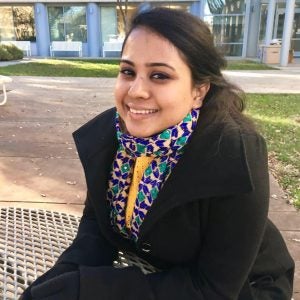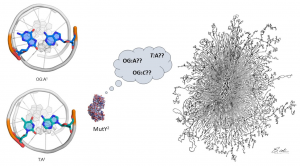
Chandrima Majumdar
Education:
B.S. Chemistry (Hons.) St. Stephen’s College, Delhi, India
M.S. Chemistry University of Hyderabad, Hyderabad, India
From: Bangalore, India
Joined the David Lab: January 2015
Outside lab: I enjoy cooking, traveling, reading and creative
activities like painting and craftwork.
Research in David Lab:
My thesis project in the David lab is focused on understanding how MutY identifies OG:A mispairs within DNA and distinguishes it from an undamaged T:A base pair. This is a challenging task for the enzyme since OG:A mispairs are innocuous and resemble a normal T:A base-pair so closely, that they do not distort the DNA helix at all. However, the failure of MutY to locate all the OG:A mispairs and initiate their repair can be disastrous as their replication forms normal, undamaged, but mutated T:A base-pairs that can no longer be corrected by the DNA repair machinery. As a result, MutY has the unique and crucial role of weeding out and initiating the repair of the OG:A mispair, while being able to distinguish it from the vast excess of undamaged DNA. I use structural analogs of OG and A to study the process by which MutY recognizes these mispairs. The analogs have functional groups with modified steric, hydrogen bonding and electronic properties that help us understand the role of these features in MutY’s ability to identify the lesion and excise the A.

Links to Papers from David Lab:
Previous Research Experience:
My previous research experience includes working as a summer researcher in Dr. Debashis Chakraborty’s lab at the Indian Institute of Technology Madras on developing a mild and chemoselective method for oxidizing aldehydes. I also worked on a summer project in Dr. Suvarn Kulkarni’s lab at the Indian Institute of Technology Bombay on the synthesis of carbohydrate building blocks as starting materials. While pursuing my M.Sc. at the University of Hyderabad , I did research with Dr. Rengarajan Balamurugan on the synthesis of substituted pyridines from alkenes using gold and silver catalysts.